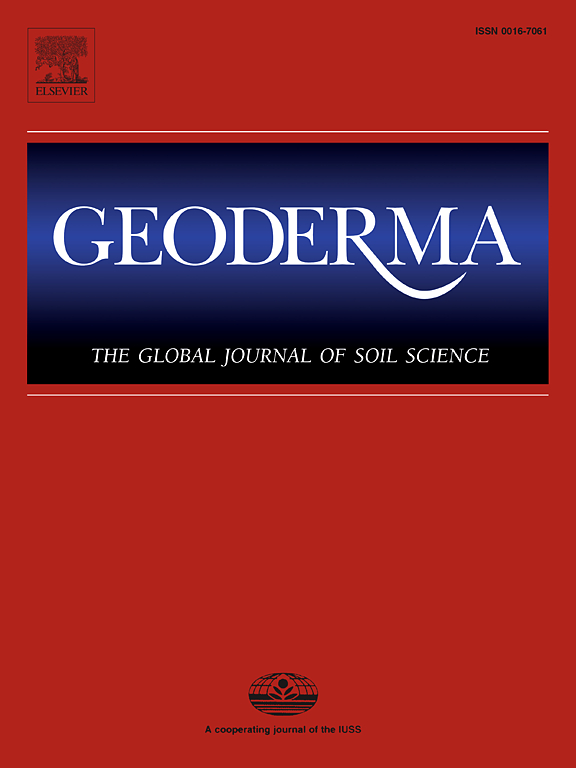表面施用有机改剂对灌溉葡萄园土壤剖面中溶解有机氮动力学和氮循环基因的影响
IF 5.6
1区 农林科学
Q1 SOIL SCIENCE
引用次数: 0
摘要
了解葡萄园土壤中溶解有机氮(DON)的动态对该农业生态系统的氮管理至关重要。本研究调查了加拿大不列颠哥伦比亚省奥卡纳根谷梅洛葡萄园灌溉土壤剖面中 DON 的动力学和动态,包括潜在的微生物机制。2011 年至 2018 年的两年期处理包括添加或不添加农用堆肥(鲜重分别为 26.7 毫克/公顷-1 和 13.7 毫克/公顷-1)的木质覆盖物和未添加堆肥的对照。2018 年秋季,以 15 厘米的间隔收集了深度为 60 厘米的复合土壤样本。通过 100 天的有氧培养,确定了微生物氮循环功能潜力,并评估了初始 DON 浓度、潜在可释放 DON(N0-DON)和 DON 释放速率常数(k-DON)。培养前的 DON 含量(0.89-44.1 毫克 N kg-1)在地膜覆盖+堆肥≥地膜覆盖> 对照中较高,并随深度的增加而降低。DON 释放遵循一阶动力学,N0-DON 在 12.1 至 188 毫克 N kg-1 之间,不受添加物的影响,但随着深度的增加而减少。累积 DON 平均为 33.8 毫克 N kg-1,也不受添加剂的影响,但随着深度的增加而减少。k-DON(0.016-0.224 wk-1)受改良剂和深度的影响,与只用地膜覆盖和对照组相比,地膜覆盖+堆肥的值更高,而且随着深度的增加而降低。有机添加物使细菌蛋白水解能力加倍,与氮参数呈正相关。培养期间,与芽孢杆菌相关的蛋白水解(npr)和硝酸盐还原(nrfA)基因与累积的 DON 和硝酸盐释放量相关,这表明蛋白水解活动释放的矿质氮被重新固定到微生物生物量中,从而保持了整个土壤剖面中植物可利用的氮。一阶动力学进一步证明了土壤生物在 DON 动态变化中的关键作用。在葡萄园等低氮系统中,DON 的供应量与矿质氮相当,并随着有机添加物的增加而增加。虽然 DON 补充剂能支持矿质氮的供应,但其潜在能力会随着时间的推移而减弱,因此需要定期施用以保持其有效性。地膜+堆肥中 Nmin 和 DON 的释放相对较快,非常适合早春施用,使氮的释放与葡萄对氮的吸收同步。这些发现对于氮源有限的有机葡萄园尤其重要。本文章由计算机程序翻译,如有差异,请以英文原文为准。
Kinetics and dynamics of dissolved organic nitrogen, and nitrogen cycling genes in the soil profile of an irrigated vineyard with surface-applied organic amendments
Understanding the dynamics of dissolved organic nitrogen (DON) in the vineyard’s soil is crucial for nitrogen (N) management in this agroecosystem. This study investigated the kinetics and dynamics of DON, including underlying microbial mechanisms, in the soil profile of an irrigated Merlot vineyard in the Okanagan Valley, BC, Canada. Biennial treatments from 2011 to 2018 included wood-based mulch with or without agricultural compost (26.7 and 13.7 Mg ha−1 fresh weight, respectively) and a non-amended control. In the Fall of 2018, composite soil samples were collected at 15 cm intervals down to 60 cm depth. Microbial N cycling functional potential was determined, and initial DON concentrations, and potentially releasable DON (N0-DON), and the DON release rate constant (k-DON) were assessed via 100-day aerobic incubation. Pre-incubation DON levels (0.89–44.1 mg N kg−1) were higher in mulch + compost ≥ mulch > control and decreased with depth. DON release followed first-order kinetics, with N0-DON ranging from 12.1 to 188 mg N kg−1 and being unaffected by amendments, but decreased with depth. Cumulative DON averaged 33.8 mg N kg−1 and was also unaffected by amendments, but it decreased with depth. The k-DON (0.016–0.224 wk−1) was influenced by amendments and depth, with higher values in mulch + compost compared to mulch-only and control, and it declined with depth. Organic amendments doubled bacterial proteolytic capacity, positively correlating with N parameters. Bacillota-related proteolytic (npr) and nitrate reduction (nrfA) genes were associated with cumulative DON and nitrate release during the incubation, suggesting that mineral N released by proteolytic activity was re-immobilized into microbial biomass, maintaining plant-available N throughout the soil profile. First-order kinetics further support the key role of soil organisms in DON dynamics. In low-N systems like vineyards, DON supply rivals mineral N and increases with organic amendments. While DON supplementation supports mineral N supply, its potential capacity diminishes over the long term, necessitating periodic applications to maintain effectiveness. The relatively fast release of Nmin and DON from mulch + compost makes it ideal for early spring applications to synchronize N release with grapevine N uptake. These findings are particularly relevant for organic vineyards with limited access to N sources.
求助全文
通过发布文献求助,成功后即可免费获取论文全文。
去求助
来源期刊

Geoderma
农林科学-土壤科学
CiteScore
11.80
自引率
6.60%
发文量
597
审稿时长
58 days
期刊介绍:
Geoderma - the global journal of soil science - welcomes authors, readers and soil research from all parts of the world, encourages worldwide soil studies, and embraces all aspects of soil science and its associated pedagogy. The journal particularly welcomes interdisciplinary work focusing on dynamic soil processes and functions across space and time.
 求助内容:
求助内容: 应助结果提醒方式:
应助结果提醒方式:


